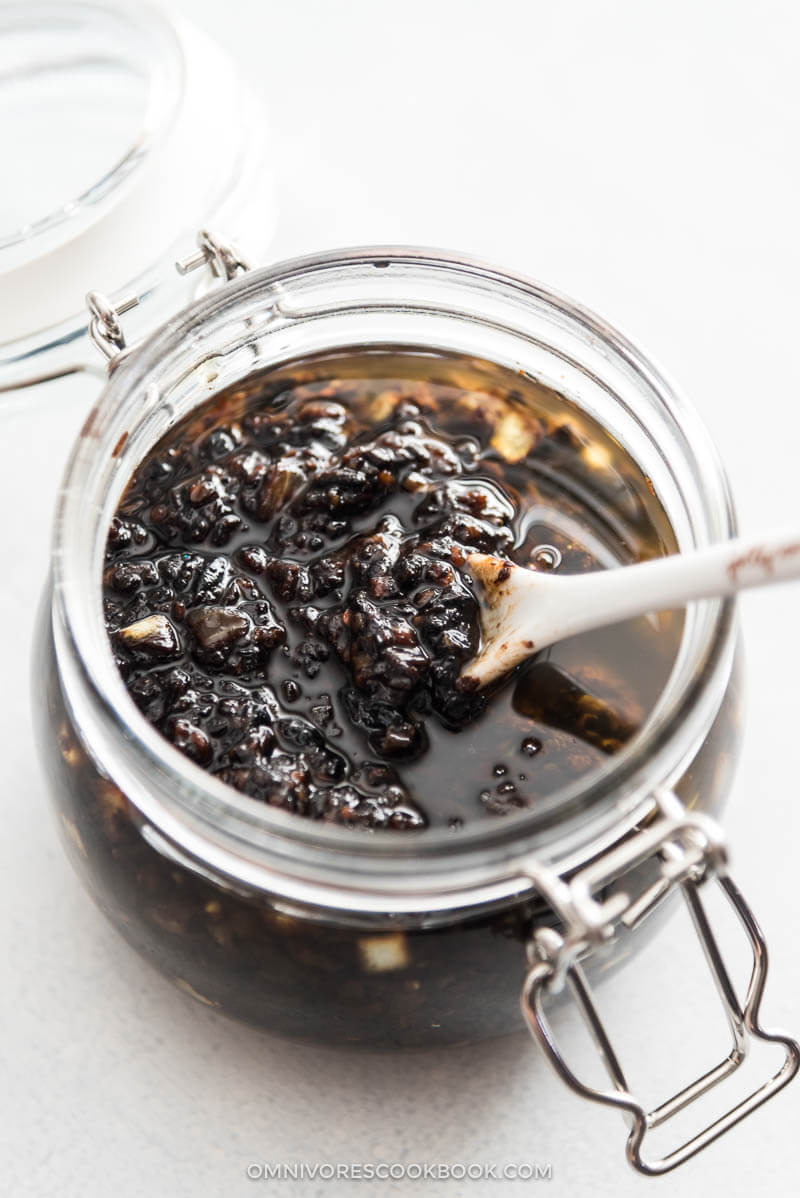
I recommend that everyone who loves Chinese food have a jar of pre-made black bean sauce in their fridge. Here are the reasons:
- The sauce is extremely versatile. You can view it as soy sauce alternative, only more flavorful.
- The sauce is healthier than many other Chinese sauces because it contains less sugar.
- The sauce has a bit of thickening powder by itself, so you don’t always need to use extra cornstarch to thicken the sauce. One more prep step eliminated!
- Not only can you make stir-fried dishes with it, you can also use it to bake or steam food, marinate meat, or serve it as dipping sauce or noodle salad dressing.
Sound amazing?
Introducing Homemade Black Bean Sauce
Yes, you can buy bottled black bean sauce from the grocery store, but the homemade version contains more fresh aromatics, does not use additional starch to thicken the sauce, and contains no additives. I always suggest that you make your own for a more delicious and healthier option.
Basic ingredient – fermented black beans
The most important ingredient is fermented black bean. It has a deep umami flavor that is similar to soy sauce, but different in flavor and even richer. This is the base of the sauce.

Thanks to almighty Amazon, you can even purchase the fermented black beans online without a trip to grocery store. However, if there is an Asian market nearby, I highly recommend you to get your ingredients there because it will be way cheaper. These black beans can stay in your fridge forever, so you can store them if you don’t have time to use them immediately.

Once you get the fermented black beans, the rest of the ingredients are quite easy to find and it’s more likely that you will already have them at home.
How to prep fermented black beans
(1) To use the fermented black beans, always rinse them with water and drain before using, so they won’t be too salty. Plus, the water will soften them to make the chopping.
(2) I always chop the beans on a cutting board so I can control the texture. I like my bean paste a bit coarse, with bits of black bean chunks to add texture. You can do this step in a food processor as well.
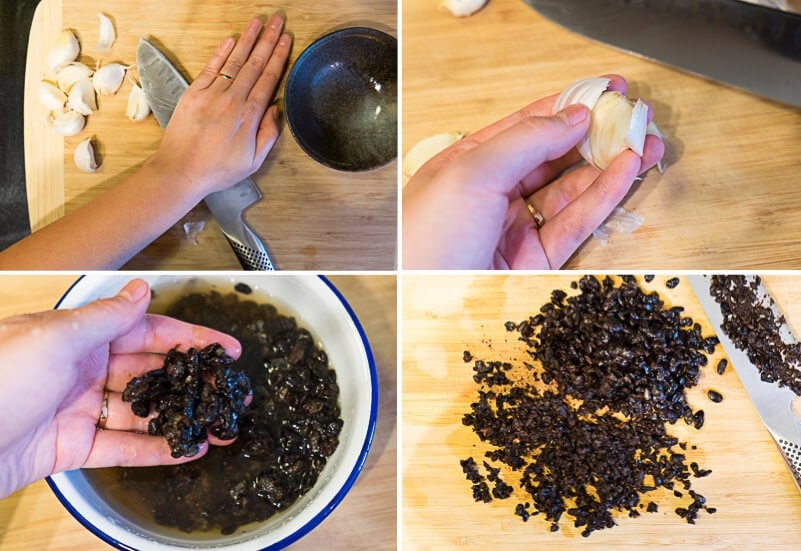
*Tip on peeling garlic faster: Lightly crush it with your chef’s knife by holding it with one hand, and press the flat side with the palm of your other hand. After this simple procedure, you only need 2 seconds to peel a clove.
Once you get all the ingredients ready, slowly roast them in a skillet. It will take 20 to 30 minutes. Please be patient and use low heat, so you won’t burn anything.
The sauce will be ready to use once it’s cooked, but it gets better after storing it for a few days.
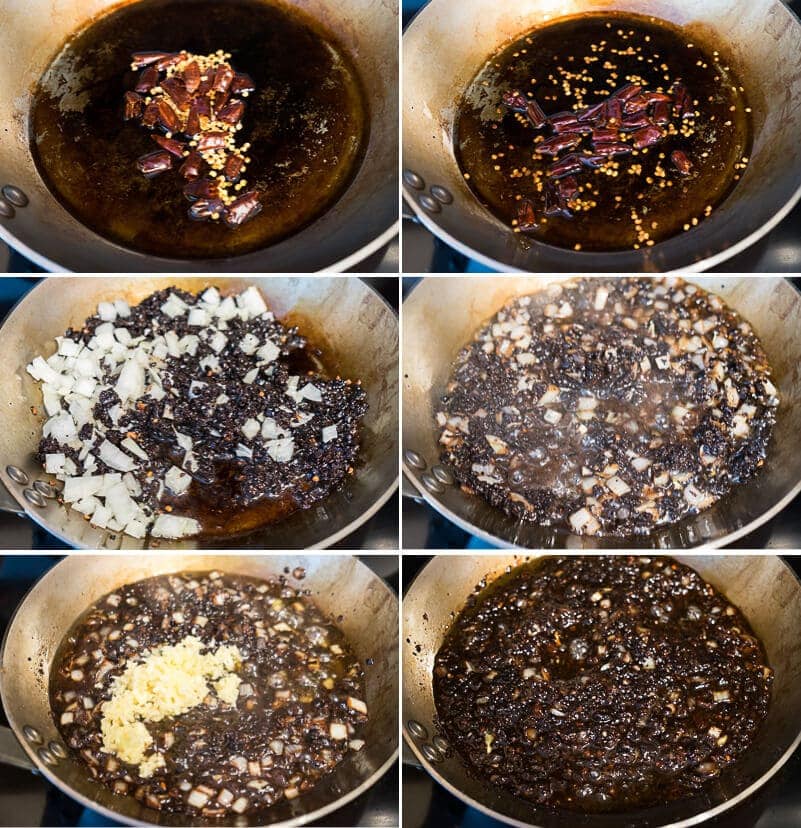
How to use homemade black bean sauce
You can use the sauce for cooking, as a marinade, a dipping sauce, or you can use it to make noodle salad. The sauce uses oil to cover the rest of the ingredients, so it will be preserved for longer time in the fridge. To use the sauce, simply scoop out the portion you need with a bit of oil. The sauce has some thickening power from the bean starch, so it’s not always necessary to add cornstarch slurry like other stir fry sauces.
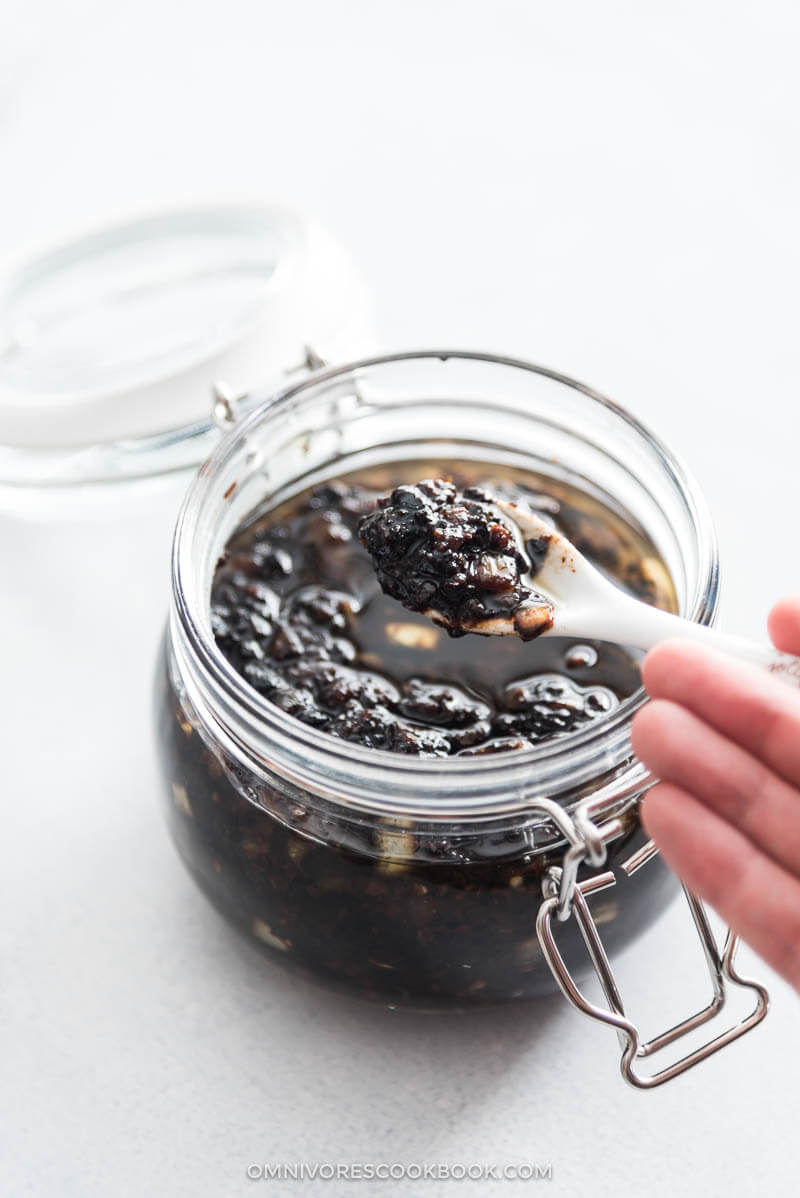
Assuming that you are going to cook 2 servings – you will need about 450 grams (1 pound) protein, or 6 to 8 cups vegetables, or 220 grams (1/2 pound) protein and 3 cups vegetables. You will need 3 to 4 tablespoons sauce.
(1) Pick 1 to 2 aromatics. Prep according to the list below. (Optional)
Since the black bean sauce contains aromatics already, you can skip this step when you’re in a hurry. However, if you have time, some extra aromatic ingredients will always make the dish taste better.
Recommended aromatics
- Ginger – 1 large piece minced (yields 2 teaspoons to 1 tablespoon)
- Green onion – 2 to 3 green onions, coarsely chopped
- Dried chili pepper – 2 to 4 peppers, torn into 3 to 4 pieces. (Or, keep whole for less spiciness.)
- Sichuan peppercorns – 1 to 2 teaspoons. Use it to infuse the hot oil, then discard them before adding other ingredients. (See this recipe to learn how to use them.)
- Shallot or onion – 1 shallot or 1/2 onion, thinly sliced or diced
(2) Choose and cut the protein.
Recommended Protein
- Beef (flank steak or short ribs) – Thinly sliced (1/8 to 1/4-inch thick), or cut to strips for stir fry.
- Chicken (skinless boneless breast or thigh) – Diced to 1-inch pieces, or sliced to 1/4-inch thick pieces for stir fry. Use whole pieces for grilling or baking.
- Pork (tenderloin or loin) – Thinly sliced (1/8 to 1/4-inch thick), or cut to strips for stir fry. Use larger cuts, such as pork chops, for baking, pan searing, or grilling.
- Shrimps – Peeled and deveined for stir fry or grilling.
- Fish fillet – Grilled, baked, or steamed with the sauce.
- Tofu (firm or extra firm) – Diced to 1/2 to 2/3 inch pieces for stir fry or braising.
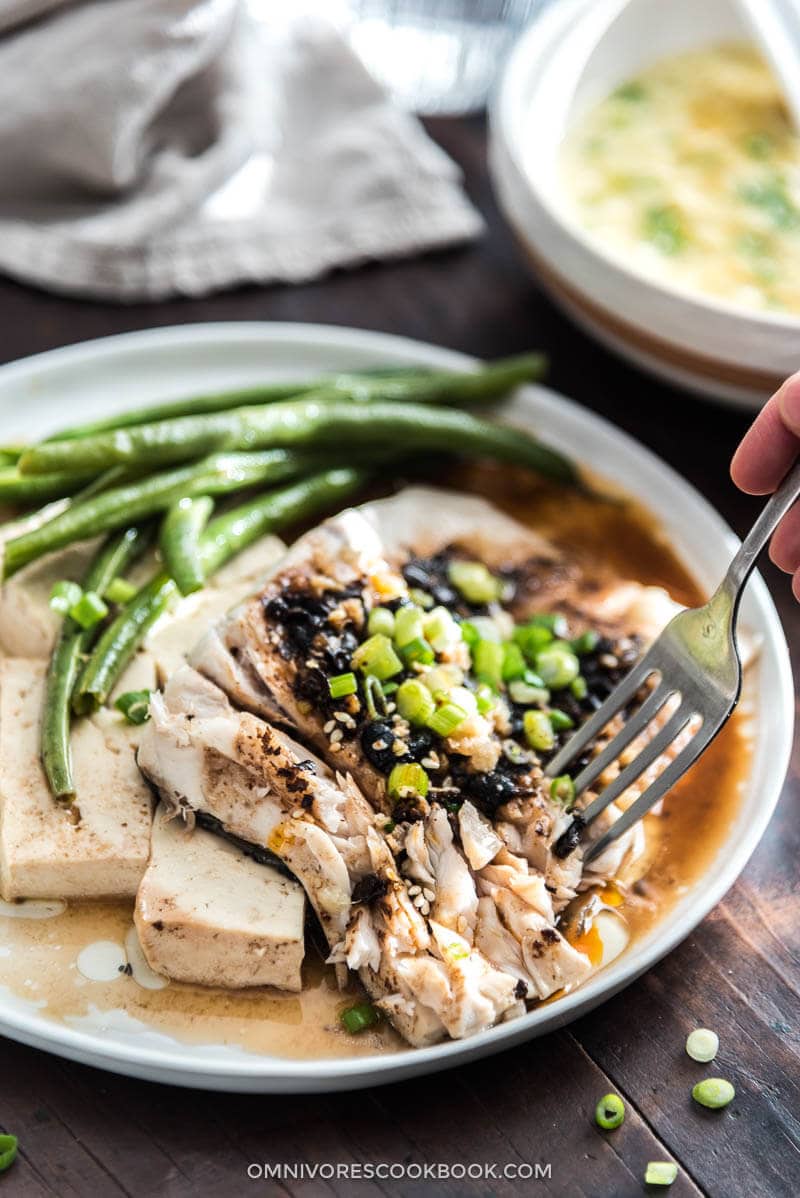
(3) Marinate and prep the protein.
For each pound of meat or seafood (for stir fry), mix with 1 tablespoon vegetable oil (or peanut oil), 1/2 teaspoon salt, and 1 tablespoon cornstarch. Let it marinate for 5 to 10 minutes. Skip this step if you’re using the sauce to bake, grill, or pan fry.
For tofu (for stir fry), marinate with 2 tablespoons soy sauce and 1 tablespoon syrup (or honey) for 10 to 15 minutes. Drain and coat with a thin layer of cornstarch. See this post to learn how to cook crispy tofu without deep-frying. Skip this step if you use the sauce (and stock) to braise tofu.
(4) Cut and prep the vegetables.
To make a quick dinner, my favorite method is to only use one type of vegetable. You can use two, but no more.
Recommended vegetables
- Asparagus – Chopped to 1-inch pieces
- Baby bok choy – Tear off large leaves and halve lengthwise, halve or quarter the rest.
- Bamboo shoots – Sliced
- Bell peppers – Sliced or chopped
- Broccoli (fresh) – Divide to small florets; steam or blanch. (See this post to learn how to blanch the broccoli quickly in the same stir fry pan).
- Broccoli (frozen) – Microwave for 2 to 4 minutes (depending on the quantity), so the broccoli is thawed and luke warm, but not heated up.
- Brussels sprouts – Halved and roasted (See this post for how to roast Brussels sprouts).
- Cabbage (green and red) – Coarsely chopped
- Cauliflower (fresh) – Divide to small florets; steam, blanch, or roast.
- Cauliflower (frozen) – Microwave for 2 to 4 minutes (for stir fry), or roast (see this post to learn how to crisp up frozen cauliflowers in the oven).
- Carrot – Sliced into pieces or strips (by using a julienne peeler); or cut to chunk and roast.
- Celery – Sliced or diced
- Eggplant – Sliced. (See this post to learn how to prep eggplant so it crisps up during stir frying.)
- Green peas (fresh or frozen)
- Kale – Stalk chopped to small pieces, leaves coarsely chopped
- Mustard greens – Chopped
- Mushrooms – Sliced or quartered
- Okra – Sliced
- Onion – Sliced
- Spinach – Roughly chopped for larger spinach. No need to chop baby spinach.
- Snow pea
- Zucchini – Seeded and sliced
(5) Make the stir fry, or use the stir fry sauce for baking, grilling, or steaming
Read this post to learn the basic steps of making Chinese stir fry.
To learn how to use Black Bean Sauce now, go to:
- Chicken Stir Fry with Black Bean Sauce
- Fish with Black Bean Sauce (Steamed and Baked Versions)
- Grilled Chicken with Black Bean Sauce
- Zucchini Stir Fry with Black Bean Sauce
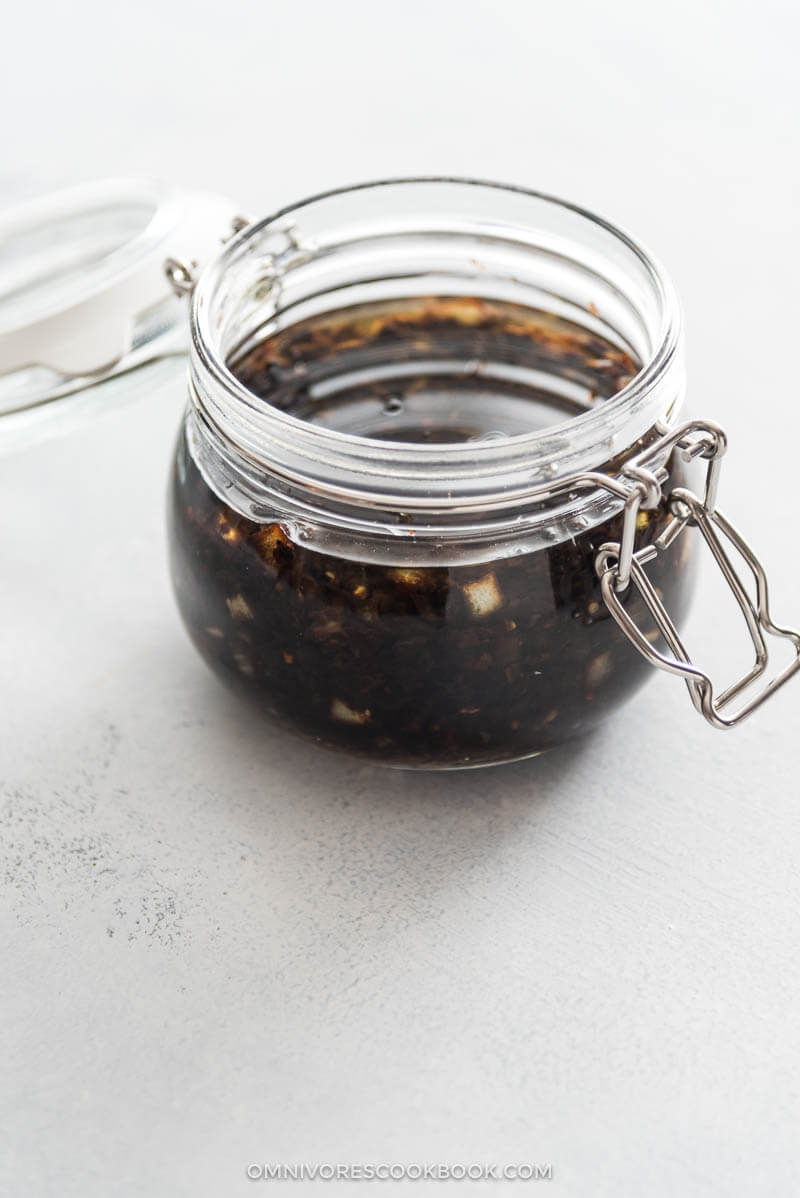
More Chinese sauce recipes
- Hoisin Sauce
- Orange Sauce
- General Tso Sauce
- Kung Pao Sauce
- Vegetarian Oyster Sauce (Vegan Stir Fry Sauce)
If you give this recipe a try, let us know! Leave a comment, rate it (once you’ve tried it), and take a picture and tag it @omnivorescookbook on Instagram! I’d love to see what you come up with.
Chinese Cooking Made Easy
Are you new to this website? This free email series is a great place to start. I’ll walk you through a few of my most popular recipes and show you how and why they work. You’ll quickly start to cook better Chinese food in your own kitchen.
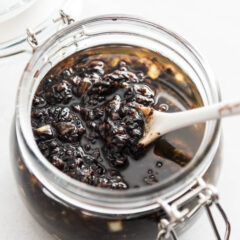
Homemade Black Bean Sauce
Ingredients
- 1 cup fermented black beans
- 1/3 cup vegetable oil
- 1/4 white onion , minced
- 4 to 6 dried chili peppers , torn to small pieces (*Footnote 1)
- 1/4 cup Shaoxing wine (or dry sherry, or Japanese sake) (*Footnote 2)
- 1/4 cup light soy sauce (or soy sauce, or tamari for gluten-free option)
- 1/4 cup sugar (or brown sugar)
- 1 head garlic (8 to 10 big cloves, minced (*Footnote 3)
- 1 thumb ginger , minced (*Footnote 4)
Instructions
- Rinse fermented black beans with tap water, drain, and coarsely chop them. I like to leave some bigger pieces of the beans, to give the sauce more texture.
- (Optional) You can use a food processor to mince all the ingredients. Add black beans, onion, and garlic into a food processor. Blend until both ingredients are minced, but not a fine paste.
- Heat oil and dried chili peppers in a saucepan over medium heat until warm. Turn to medium low heat. Cook until the chili peppers turn dark, but not black. Stir occasionally. Scoop out the chili peppers and discard them.
- Add the black beans and onion. Cook and stir, until the sauce looks a bit dry. (The beans will absorb oil at first, but release the oil once they’re cooked.)
- Add Shaoxing wine, light soy sauce, and sugar. Simmer and stir until the onion turns tender. It takes about 10 minutes or so. The sauce can be easily burned, so make sure to keep the heat low and stir the sauce constantly to ensure even cooking.
- Add garlic and ginger (if you’re using these ingredients). Continue to cook and stir the sauce until the onion turns very tender. You should see oil floating on top of the sauce.
- Transfer the sauce to a large bowl to cool off completely.
- Store the sauce in an airtight jar in the fridge for 2 weeks to a month.
Notes

Did you make this recipe?
I’d love to hear how it turned out for you! Please take a moment to leave a 5-star rating ⭐️ and share your thoughts in the comments further down the page. It really helps others discover the recipe too.

Kate Shilling
Hi Maggie! Fermented black beans have been on my list for my next Chinatown shopping expedition. Do you have a favorite grocery store in Chinatown here in NYC that you recommend? I’ve been to a few and always love exploring the ingredients!
Maggie
Hi Kate, I would go to Hong Kong market if I want to grab something real quick. It’s very big and is usually well stocked, so you can get almost everything. It has a good size produce section too but the vegetables are not the freshest. I like to walk through Grant Street, where you can find many outdoor vendors who has much better vegetables. I think one of them is called Ken Hing Food Market that has fresh produce (I googled it although I’m not sure it’s the one because I usually just walk by and never remember the exact location). Btw I have an article of Chinese greens in case you want to try out a different produce: https://omnivorescookbook.com/chinese-greens/
Our favorite vegan dim sum spot is Buddha Bodai, and the Chinese spot is Deluxe Green Bo. Last week I walked by Chinatown, I saw many dim sum shops have opened outdoor seating. It can be fun to enjoy some dim sum there if you don’t mind the crowd.
Not Chinese but Tomiño Taberna Gallega is our favorite Spanish tapas spot (between Chinatown and Little Italy). The food is SO GOOD (best Spanish omelete, it has runny eggs inside). They have two outdoor tables so if you want some booze and small bites, it’s perfect.
NancyL
Thank you for this recipe!
fsg
I will be making it soon, ,
recipe and preamble has me itching to begin immediately
: – )
Matt
Just made this sauce and it’s amazing!! Great flavor and just the right amount of heat. I used all the ingredients and would likely go heavier on the ginger next time. Can’t wait to try it on some dishes soon.
Mine came out a bit on the salty side to the point that I am not sure how much I can use in each “serving”. Is there a way to reduce the saltiness of the beans? I rinsed them beforehand for a minute of so prior to chopping. Thoughts?
Didina Gnagnide Angorinie
Hi, I really appreciate your site. About this sauce I have two questions:
1)do you think it could be made (and still be flavorful) without any alliums (onion, garlic, scallions, etc)?
2)is there an alternative to fermented black soybeans that does not contain high amounts of phytoestrogens?
Both questions are due to my dietary requirements 😭
Maggie
I’m afraid it’s not gonna work for this recipe. One sauce is actually similar to this is Tian Mian Jiang (sweet wheat sauce): https://themalamarket.com/collections/all/products/sichuan-sweet-wheat-paste-tian-mian-jiang?aff=2 It’s mostly made with fermented wheat flour and salt.
It doesn’t contain alliums and phytoestrogens in it.
Queenie
Hi there, I have been looking for a way to make Korean jajangmyeon but live in an area without Asian stores. I LOVE black beans and grew up eating them in just about everything when growing up in NYC’s Chinatown. I have never heard of jajangmyeon until recently and it looks so good I want to make it. But I wonder if this sauce is the same as what would be considered jajang sauce? I have a massive jar of fermented black beans in my fridge.
Maggie
Hi Queenie, this sauce is different from the jajang sauce I’m familiar with but taste close. I think the Korean version uses different approach so if a recipe uses black bean sauce, you can definitely use this recipe.
I grew up eating Northern Chinese jajang noodles and I have a recipe for it: https://omnivorescookbook.com/homemade-zha-jiang-mian-fried-sauce-noodles/
I’d love to look into replacing the traditional tian mian jiang (fried sauce noodles) with this one but I’m afraid I don’t have a recipe now.
Shreena
Hi Maggie
I’ve just stumbled across this recipe and it sounds fantastic.
I’m vegetarian and would be interested in using it for a tofu in black bean sauce. I had a look at your stir fried chicken with black bean sauce recipe and noticed it uses oyster sauce and sake.
Is there an alcohol free and vegetarian alternative to making It so I can enjoy a delicious tofu black bean Sauce? Xxx
Christi
Hi Maggie!
I LOVE your site! It has become my go-to for Chinese recipes.
Do you have any recommendations for a sugar substitute? I have been able to successfully use substitutes like Stevia in some recipes but for this one I’m wondering if replacing the sugar it will ruin the consistency of the sauce.
Maggie
Hi Christi, I think it should be fine to replace the sugar. The fermented black beans are quite starchy, so the sauce will thicken eventually.
If you use stevia, be carefully of the amount. Maybe add less at the beginning and taste the sauce as you go. It is a salty sauce and the sugar should be on the background and add richness.
Kerrie
Thank you so much for sharing this recipe. I read on another blog that Fermented soybean sauce can be used as a substitute for doubanjiang in MaPo sauce in a pinch. The recommendation was to add chile. Do you think this would work?
Maggie
I Kerrie, I’m pretty sure it will work. Both has a fermented taste and should work great with tofu. If you have homemade chili oil, you can scoop a tablespoon of the chili flake from it, and add more chili oil to the mapo tofu along with the black bean sauce. It should be super delicious!
Here is the chili oil recipe: https://omnivorescookbook.com/how-to-make-chili-oil/
Gordon Szeto
I have fond memories of a restaurant that my family always went to since I was born. One of their best dishes and one that has always been on my mind is their black bean chicken dish. Sadly they are no longer in business and I have been wanting to make black bean chicken for so long! i finally decided to and while researching I came across your recipe for the sauce. It was delicious! I am not sure if my dish lived up to my memory (haha does anything?) but I think it was pretty close. Either way it was fantastic! Thank you!
Ethan Boatner
But I want to know how to ferment the dried beans themselves. These recipe look great, but say “add the fermented beans.” Did I miss that part, or, how can I find out how to ferment my sack of dried beans? Thanks!
Maggie
Hi Ethan, these Chinese fermented black beans are quite special – the soy beans are boiled and then fermented in a solution for a year to create the special taste. I don’t think it’s something you can make at home. You can easily purchase them on Amazon (http://amzn.to/1PM90DG) or in an Asian grocery store.
Kathi
I Love, love, love this recipe! I make a full recipe and have much left over. The next time I make a stir fry, I use some of this sauce. Its easy and delicious! It lasts a long time in an airtight container in the fridge too.
Casey
Brilliant recipe! Simple, but full of flavour.
Tristian
Thanks for this, this is exactly what I needed.. I have made a batch for my stir fry needs and now this is my go to base for any barbecues, weekly stir fry’s. I will never buy bottle sauce again!
Rhonda
Hi Maggie,
Made this yesterday to use as a dipping sause with your salt and pepper chicken, it is heavenly! When I saw this recipe, I couldnt order those fermented soy beans fast enough! We dont have a local store that carries this. Seems like the only restaurant around here that had this was P.F.Changs, and they were always stingy with the amount that you got! Now I have all I want, and its much better than what they serve. Cant wait to have some for lunch! Thinking up other uses for the next 30 days since hubby doesnt care for it, so its all mine, mine I tell you!!
Angela McCall
My husband is Celiac so I put in gf soy sauce this was the first time we have had black bean sauce in five years was brilliant wish I found this recipe sooner .
Wendy Allott
Hi. My sauce didn’t turn out as black as yours. But, I did leave out the chili. Is that why?
Maggie
I don’t think it’s the chili that’s causing the issue. The main ingredient in this recipe is fermented black beans, which are black. The color of the sauce should turn out black as the fermented beans.
Wendy Allott
I’ve just realised, I don’t think my black beans were fermented, I think they were just beans. It still tasted delicious. My kids even loved it and they’re fussy.
Bittu thapa
Vry vry nice
Lily
Can we use this in jajangmeon?
Maggie
Hi Lily, you can add some black bean sauce into a jajangmeon sauce, which adds a nice umami taste. But the main base of jajangmeon should still be sweet bean paste (made from wheat flour and sugar). I have a recipe here: https://omnivorescookbook.com/homemade-zha-jiang-mian-fried-sauce-noodles/
Brent
This looks wonderful! I see the recipe calls for heating chile peppers in oil, and in the Note you refer to Thai chiles, but how many? And are there alternatives? My grocer has lots of Mexican peppers — would Japones work?
Maggie
Hi Brent, you can totally use dried Mexican peppers (5 to 6). Sorry if the recipe wording is confusing. I actually called mild dried chili peppers (not Thai chili). I just slightly edited the recipes.